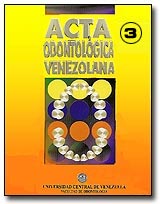DISPOSICIÓN DEL CONDUCTO DENTARIO INFERIOR EN EL CUERPO MANDIBULAR. ESTUDIO ANATÓMICO Y TOMOGRÁFICO
Palabras clave:
Tomografía espiral convencional, Mandíbula, Conducto dentario inferior, conventional spiral tomography, Jaws, mandibular canalResumen
El objetivo del presente estudio fue determinar la distancia entre el conducto dentario inferior (CDI) y las tablas óseas lingual (TL), vestibular (TV) y basal (RB) en cuatro sectores del cuerpo mandibular. Se utilizaron diez mandíbulas que presentaban la región premolar y molar edéntula. Se evaluaron mediante tomografía espiral convencional (Cranex TOME multifuctional unit, Soredex, Finlandia) y examen visual directo, posterior a la osteotomía. Se realizaron mediciones desde el CDI hasta TL, TV y RB; a nivel del segundo premolar, primer molar, segunda molar y tercer molar. Los resultados obtenidos se evaluaron estadísticamente con las pruebas Kolmogorov-Smirnov, ANOVA y test de Levene; las cuales demostraron homogeneidad y distribución normal entre las medidas de los especímenes y las tomografías (p>0.05). Al analizar las medidas mediante ANOVA y Kruskal-Wallis se encontró que el diámetro del CDI y la distancia hacia la TL eran constantes en los cuatro sectores del cuerpo mandibular (p>0.05). El diámetro del CDI presentó un rango de 2.3mm a 2.6mm y la distancia a TL de 2.5mm a 2.8mm. Las distancias a RB y TV presentaban diferencias estadísticamente significativas (p<0.05). El presente estudio demuestra que el diámetro del CDI en el cuerpo mandibular es constante y recorre el cuerpo mandibular con mayor proximidad a la TL.ABSTRACT
The aim of the current study was determine the distance between mandibular canal (CDI) and lingual (TL), labial (V) and basal cortical bone (RB) in four mandibular body areas. Ten mandibular bones showing premolar and molar edentulous region was used. They were assessed by Conventional Spiral Tomography (Cranex TOME multifuctional unit, Soredex, Finland) and a direct visual exam following osteotomy. Measures were made from CDI to TL, TV and RB; at second premolar, first molar, second molar and third molar level. Gotten results were assessed by ANOVA, Kolmogorov-Smirnov and Levene tests that showed homogeneity among specimens measures and Tomographies (p>0.05). ANOVA and Kruskal-Wallis were used to refer measures where CDI diameter and the distance to TL were constant in the four mandibular body areas (p>0.05). CDI diameter showed a rank from 2.3mm to 2.6mm and a distance of 2.5mm a 2.8mm to TL. The distances to RB and TV showed statistically significant differences (p<0.05). The current study shows that CDI diameter remains constant and CDI runs mandibular body near to TL.
Descargas
Los datos de descargas todavía no están disponibles.

